Krita
|
| |
|
Krita 2.8 running on Trisquel GNU/Linux 6.0 | |
| Developer(s) | KDE |
|---|---|
| Initial release | 21 June 2005 |
| Stable release | 3.0.1 (6 September 2016[1]) [±] |
| Preview release | 3.0.0 RC 1 (18 May 2016[2]) [±] |
| Repository |
projects |
| Development status | Active |
| Written in | C++, Qt |
| Operating system | Unix-like, Windows,[3] OS X[3] |
| Type | Raster graphics editor |
| License | GNU General Public License v2 and above |
| Website |
krita |
Krita is a raster graphics editor based on Qt 5 and the KDE Frameworks 5. Krita is designed to be a digital painting application. It has been influenced to some extent by software like Corel Painter and SAI. Krita packs with some key features different from most of its kind, including the ability to work with both bitmap and vector illustration. The developers also strive to simplify user interaction and focus on features more relevant to painting and drawing.
Krita is a free software distributed under GNU General Public License version 2 and above. It was initially released as a part of KOffice version 1.4.0, on June 21, 2005.

Vision
Krita's vision is defined on the official website as:[4]
| “ | Krita is a KDE program for sketching and painting, offering an end-to-end solution for creating digital painting files from scratch by masters.
Fields of painting that Krita explicitly supports are concept art, creation of comics and textures for rendering. Modelled on existing real-world painting materials and workflows, Krita supports creative working by getting out of the way and with snappy response. |
” |
Origin of name
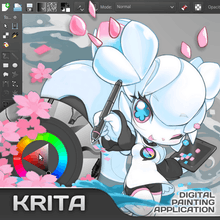
A README file accompanying Krita's source code states:
| “ | Krita is a paint application for raster images. It's also, according to the Dictionary of Phrase and Fable:
The first of four Hindu periods contained in the great Yuga, when the genius of Truth and Right, in the form of bull, stood firm on his four feet, and man gained nothing by iniquity. In the Mahabharata, the name 'krita' is used in a context where this can be translated with 'perfect' – the perfect age. Krita is Swedish for crayon and rita means "to draw". |
” |
Mascot
Krita's mascot is Kiki the Cyber Squirrel, an anthropomorphic squirrel character designed by Tyson Tan. The early version of Kiki was submitted to KDE forum in 2012 and was first used in Krita 2.6's introduction booklet.[5] A revised version was used as Krita 2.8's splash screen,[6][7] as well as the merchandise shop items[8] and Krita's Steam box art, cover art and project avatar.[9][10]
Features
Krita has the following notable features:[11]
- An adaptive multi-modal interface which works on the desktop and touchscreens
- A large set of default brushes
- Customizable brush presets
- Multiple brush engines, supports pressure sensitivity, tilt and other features of graphics tablets
- Wrap around mode canvas for creating and visualizing seamlessly tiled textures
- OpenGL powered canvas with high-bit-depth monitor support
- Filters with real-time preview
- A layer engine that allows deeply nested and grouped layers
- Vector, clone, external-file and dynamic filter-effect layers
- Supports a wide range of file formats and color models
Interface and workspace
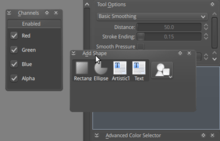
Krita has a highly customizable interface designed for desktop and touchscreens. Users may change Krita's window color theme, customize icons shown in toolbars and relocate tool dockers. Keyboard shortcuts can be edited as well. Krita allows user to save a given set of dockers as a workspace and switch between them.
Dockers
Krita has the following dockers available: preset selector, layer management, channel management, various color selectors, tool options, shape selector, composition docker, undo history, pattern selector, task sets, scripts and various dockers for working with vector objects. Krita's dockers can be freely relocated around its window, users can:
- Choose which dockers they want to be displayed
- Collapse a docker by clicking on the top-left icon
- Place any dockers into Krita's top, left or right panel
- Make a floating docker by drag-and-drop it onto the canvas
- Group multiple dockers to share the same vertical space
- Switched between grouped dockers by tabs
- Lock docker position (Krita 2.9 alpha)
Brush interaction
Krita's brush interaction has been designed to simplify the painting process. Users can access many frequently used functions simply by holding down modifiers and apply stylus command.
| Operation | Command |
|---|---|
| Change brush size | Shift (hold) + drag |
| Temporary color picker | Ctrl (hold) |
| Move canvas | Middle mouse button (hold) + hover pointer movement |
| Zoom canvas | Ctrl (hold) + hover pointer movement (up or down) |
| Rotate canvas | Shift (hold) + hover pointer movement (around) |
Right-click palette
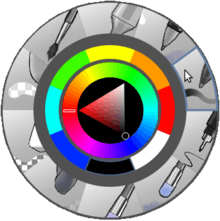
When right-click on the canvas, Krita displays a round palette with frequently used operations, including:
- Favorite tool presets (up to 30, editable)
- Color Ring
- Recently used colors
Canvas
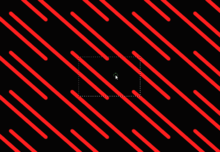
Krita can rotate and mirror its canvas realtime with OpenGL acceleration that supports high-bit depth monitors. It has a large set of options available to create a no-distractions canvas-only painting mode. Krita also has a wrap-around canvas mode (also known as image offset tool) to create seamless textures.
Tools
Krita has many raster graphics and vector tools. Each tool has its own tool options.
Raster tools
Krita has the following raster tools: freehand, line, rectangle, ellipse, polygon, polyline, star, path, dynamic movement, multihand, crop, move, transform and warp, measure, fill, gradient, color picker, assistants, perspective grid, grid, select rectangle, select ellipse, freehand selection, select polygon, select outline, fill select, select similar colors, path select, zoom and pan.
Vector tools
Krita has the following vector tools: path, selection, text, artistic text, calligraphy, fill and gradient.
Brush system
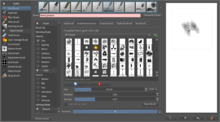
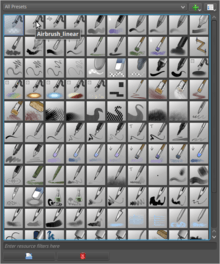
Krita is designed towards digital painting. It has a highly customizable brush system and is shipped with more than 100 brush presets. Krita's brush system provides various blending modes and has independent engines for the following tool models: pixel, smudge, duplicate, filter, hairy, hatching, texture, chalk, color smudge, curve, deform, dyna, experiment (Alchemy), grid, particle, sketch and spray brushes. Brush settings can be saved as presets and shared. As of Krita 2.9 alpha, it also supports multibrush painting.
Filters
Krita supports filters. The result of a filter can be previewed on the image itself in realtime.
Krita has the following filters by default: levels, color adjustment curves, brightness/contrast curve, desaturate, invert, auto contrast, HSV adjustment, pixelize, raindrops, oil paint, gaussian blur, motion blur, blur, lens blur, color to alpha, color transfer, minimize channel, maximize channel, top/left/bottom/right edge detection, sobel, sharpen, mean removal, unsharp mask, gaussian noise removal, wavelet noise reducer, emboss horizontal only/in all directions/(laplacian)/vertical only/with variable depth/horizontal and vertical, small tiles, round corners, phong bumpmap.
Layers
Krita has multiple layer modes including: raster layers, vector layers, filter layers, programmatically generated layers, group layers and file-backed layers. Layers can have transparency, filter and local selection masks. Layers can be dragged and dropped within Krita, between instances of Krita or as images to and from other applications. Layers in Krita can be rotated, scaled, converted, sheared. Krita's vector layers support text, vector shapes and filters on vector shapes.
Generators
Krita's generators create pixels and can be used in generator layers. Krita has the following generators: color and pattern. More generators can be added as plugins written in C++.
Color management, color models and channel depths
Krita always uses color management. On Linux, if the monitor is correctly set up with colord or oyranos (GUI settings applications available for GNOME and KDE), the display calibration will be used automatically. Krita supports the following color models for creating and editing images: RGBA, Gray, CMYKA, Law, YCbCr, XYZ in 8 bits integer, 16 bits integer, 16 bits floating point, 32 bits floating point.
File formats supported
Krita supports a large number of file formats. Krita's native document format is Krita Document (.kra), it can also work with OpenRaster document as a saving format.
| File formats | |
|---|---|
| Save to | Krita Document, OpenRaster document, PSD image, PPM, PGM, PBM, PNG, JPEG-2000, JPEG, BMP Windows, XBM, TIFF, EXR, PDF, WEBP |
| Import only | Krita Document, EXR, OpenRaster document, PSD image, Gimp image, PPM, PGM, PBM, PNG, JPEG-2000, PDF, ODG draw, BMP Windows, XPM, GIF, XBM, Krita Flipbook, Adobe DNG negative and Camera RAW, WEBP |
| Export only | / |
History
| Year | Venue | Date |
|---|---|---|
| 2005[12] | Deventer, Netherlands | |
| 2010[13] | Deventer, Netherlands | 2/26-3/7 |
| 2011[14] | Amsterdam, Netherlands | 5/20-5/22 |
| 2014[15] | Deventer, Netherlands | 5/16-5/18 |
A "KImage Shop" was proposed by KDE founder Matthias Ettrich on 24 May 1999, following dissatisfaction with the GIMP's user interface.[16] As that name clearly indicates, KImageShop was meant to be a Photoshop clone. Before any public release, it was called KImageShop and then later Krayon, until legal matters motivated a change from these names. As early as 2004 a desire for a change of focus was apparent: "I want Krita to occupy the niche Corel Painter has in the Windows world, not Photoshop."
Krita Sketch
On 14 December 2012, a new touch screen-optimized version of Krita called “Krita Sketch” was released.[17][18] This was a joint collaborative work between Intel and Krita team for “a major marketing campaign”.[18] Krita Sketch is mainly designed for Windows 7 and 8[18] and uses “Modern UI” theme coined by Microsoft for Windows 8.
Krita Foundation and Krita Studio
In December 2012, a foundation to support Krita was created.[19] In order to fund the development of Krita Desktop and Krita Sketch, KO GmbH launched a new commercially supported version of Krita which is an extension of Krita Desktop to use in movie and GFX studios.[20]
Crowdfunding campaigns
In 2014 the Krita Foundation turned to kickstarter to crowdfund the development. their first Kickstarter campaign Krita: open source digital painting | Accelerate Development[21] was successful and resulted in the 2.9 release which was released in 2015. A second campaign was started in 2015: Krita: free paint app - let's make it faster than Photoshop! with the main goals of making krita faster and adding animation support.[22] This campaign resulted in the 3.0 release which was released in 2016. A 2016 Kickstarter campaign was started as Krita 2016: Let's Make Text and Vector Art Awesome! to create better vector support and text tools.[23]
See also
- Comparison of raster graphics editors
- Linux color management
- Comparison of office suites
- OpenRaster
- Blender (software)
References
- ↑ "Krita 3.0.1: new features and bug fixes".
- ↑ "Krita 3.0 Release Candidate 1 Released".
- 1 2 "Krita Desktop | Krita". Krita Foundation. Retrieved 2016-05-30.
- ↑ "Krita FAQ: What is Krita?". krita.org. Retrieved 24 December 2015.
- ↑ "About Krita 2.6 Booklet" (PDF). Krita Foundation.
- ↑ "Calling for Splashes!". Retrieved 22 February 2014.
- ↑ "Krita's Git commit of Krita 2.8's splash".
- ↑ Far, Maria. "Awesome designs by Tyson Tan!". Krita Foundation. Retrieved 22 February 2014.
- ↑ "Krita's Steam page". Retrieved 22 February 2014.
- ↑ Tan, Tyson. "Krita the Digital Painting App is now on Steam". Retrieved 22 February 2014.
- ↑ "Krita Features". Krita Foundation. Retrieved 22 February 2014.
- ↑ Boudewijn Rempt (2005-07-30). "And on the fifth day...". valdyas. valdyas.org.
- ↑ Boudewijn Rempt (2010-03-15). "Second Krita Sprint Ends With Tea". KDE. KDE.NEWS.
- ↑ Boudewijn Rempt (2011-06-02). "What happens When Artists and Developers Come Together: The 2011 Krita Sprint". KDE. KDE.NEWS.
- ↑ "2014 Krita Sprint in Deventer, Netherlands". KDE.news. 2014-06-04. Retrieved 2016-07-16.
- ↑ "'KImage Shop? [was:Re: K abiword port]' – MARC". Lists.kde.org. 1999-05-24. Retrieved 2012-04-23.
- ↑ "Krita Digital Painting – Krita Sketch". KO GmbH. Retrieved 2013-04-26.
- 1 2 3 Anne-Marie Mahfouf (2012-12-19). "Krita Sketch – Mobile Artistry". KDE.News. Retrieved 2013-04-26.
- ↑ "Announcing the Krita Foundation". Krita.org. 2012-12-17. Retrieved 2013-04-26.
- ↑ "Krita Digital Painting". KO GmbH. Retrieved 2013-04-26.
- ↑ "Krita: open source digital painting - Accelerate Development".
- ↑ "Krita: free paint app - let's make it faster than Photoshop!".
- ↑ "Krita 2016: Let's Make Text and Vector Art Awesome!".
External links
- Official website
- Krita Studio website
- Krita on Steam
- Krita's Git repository
- Krita on Twitter

- Krita on tumblr
- Krita on DeviantArt
- KO GmbH website

